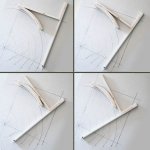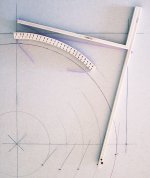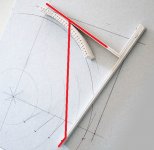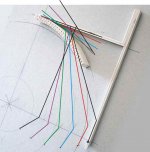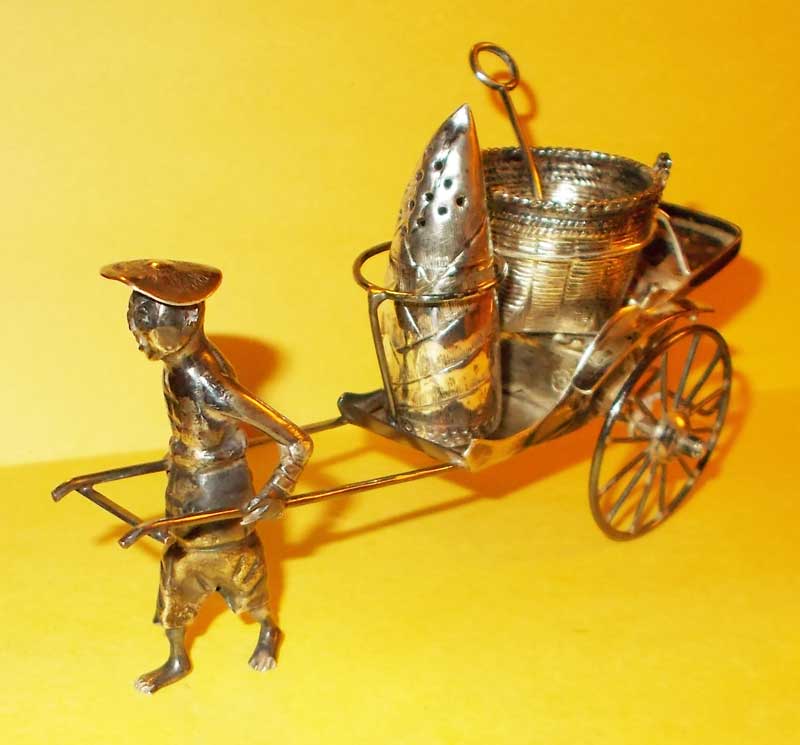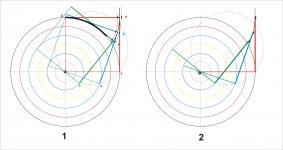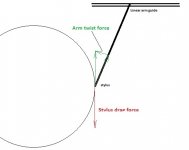So how does this pivot arrangement achieve tangential tracking? What am I missing?
It does not so you are not missing anything. Nocdplz and I went off topic, as stated in our earlier posts. The bearing idea, however, was inspired by the Schuch's Fig.1 arm drawing.
Perhaps nocdplz can start a new thread on his 3-point design... and I will surely indulge him.
Sorry again for my off topic posts (no new thread on it - nothing to teach, too much to learn, dear Directdriver), now back to tangency.
I've built a rough mock up of the Schuch-arm geometry - photos attached
First impressions:
Geometry is simply clever (simple and clever) and gives a perfect tangency from the first to the last groove
The crossed strings do honestly their job.
BUT, the whole thing does not give me the right feeling, the "moving pivot" (string at their crossing) behaves like a "floppy" unipivot (in my mockup of course: but, compared, even the worst iteration of an altmann seems rock solid)
So the most difficult task is to keep the arm in contact with the "hipflask" in a safe and precise way, with tight tolerances. But replacing strings with something more stable will not be easy
Who wants to build "his own" Schuch arm must be prepared to an hard work: good tools, right materials, skill and a lot of patience needed. This will not break down the fans of tangency, accustomed to that and worse.
i've sent too much posts - Carlo
I've built a rough mock up of the Schuch-arm geometry - photos attached
First impressions:
Geometry is simply clever (simple and clever) and gives a perfect tangency from the first to the last groove
The crossed strings do honestly their job.
BUT, the whole thing does not give me the right feeling, the "moving pivot" (string at their crossing) behaves like a "floppy" unipivot (in my mockup of course: but, compared, even the worst iteration of an altmann seems rock solid)
So the most difficult task is to keep the arm in contact with the "hipflask" in a safe and precise way, with tight tolerances. But replacing strings with something more stable will not be easy
Who wants to build "his own" Schuch arm must be prepared to an hard work: good tools, right materials, skill and a lot of patience needed. This will not break down the fans of tangency, accustomed to that and worse.
i've sent too much posts - Carlo
Attachments
Right, geometrically no need. But would it be practical to go over the "hipflask"? How it's done? And to put an LP over the platter?
What must be said is that the side that rolls on the guide must be round to allow the vertical articulation. But no round bars at home ....
c
What must be said is that the side that rolls on the guide must be round to allow the vertical articulation. But no round bars at home ....
c
wheelchair
I always admire nocdplz's graphic skill so please forgive my crude crude graphics.
Perhaps we can build a track of two rails for main arm on two ball bearings to travel, rolling forward and also acting as vertical pivot. Each wheel can be convex bearing on two curved round rods, total four rods. This way, it might lessen the binding on the wheels. The guide bar comes out of the wheel's center point touching the hipflask. My concern is that how do you keep the arm from rolling too far forward... Whaddaya think?

I always admire nocdplz's graphic skill so please forgive my crude crude graphics.
Perhaps we can build a track of two rails for main arm on two ball bearings to travel, rolling forward and also acting as vertical pivot. Each wheel can be convex bearing on two curved round rods, total four rods. This way, it might lessen the binding on the wheels. The guide bar comes out of the wheel's center point touching the hipflask. My concern is that how do you keep the arm from rolling too far forward... Whaddaya think?

Last edited:
rocking chair
making the mockup I've seen some things.
1 - geometry is determined just from the rocking of the guide bar on the surface of the "hipflask" (along one line only); Any distance or slippage of the guide bar from that line alters irreparably the geometry; The arm is supported only on the stylus and on that single, variable, point of contact
2 - The arm moves correctly as long as the the stylus drag pushes it forward against the "hipflask", but strings are not good if (warps, excentric lp) it may go backwards. Plus or minus a problem of all suspended arms, but here much greater. (strings ten times longer)
We need just a guide bar rocking precisely along a line. The 3 strings is a smart solution (see #1194 Diyrayk analisys), and maybe Mr. Schuch has devoted a lot of time and skill to the setup, but a steep climb for the rest of us.
I had figured a mylar strip, but it does not work, because it is inevitably too rigid. You talked about magnets (a magnetic hipflask with a v-rail for a steel guide bar?), that goes nearer the task, but how to get a uniform field, without preferential positions?
Too complicated, not my piece of cake
Carlo
making the mockup I've seen some things.
1 - geometry is determined just from the rocking of the guide bar on the surface of the "hipflask" (along one line only); Any distance or slippage of the guide bar from that line alters irreparably the geometry; The arm is supported only on the stylus and on that single, variable, point of contact
2 - The arm moves correctly as long as the the stylus drag pushes it forward against the "hipflask", but strings are not good if (warps, excentric lp) it may go backwards. Plus or minus a problem of all suspended arms, but here much greater. (strings ten times longer)
We need just a guide bar rocking precisely along a line. The 3 strings is a smart solution (see #1194 Diyrayk analisys), and maybe Mr. Schuch has devoted a lot of time and skill to the setup, but a steep climb for the rest of us.
I had figured a mylar strip, but it does not work, because it is inevitably too rigid. You talked about magnets (a magnetic hipflask with a v-rail for a steel guide bar?), that goes nearer the task, but how to get a uniform field, without preferential positions?
Too complicated, not my piece of cake
Carlo
If we have to use string AND wheels, then we should just stick to the Birch geometry for lucidity and use a string tied to a fixed point "P" and the other end tied to the midpoint of the axle of the two wheels as guiding mechanism. I think this rickshaw method might have something going for it... I know from previous discussions that this approach will likely result in some skating force as the cartridge gets closer to the spindle. Another potential problem is when encountering eccentric records, the string might slack and result in unpredictable consequences like skipping.
Hi No CD plz, rethinking it seems there is a skating force with the Schuh geometry and with my shortcut variant too. Because the line from the stylus tip to the pivot point (that is rolling on the hipflask arc) is in angle with the cantilever (tangent of groove).Ops. dear Icszazar,
I gave you a wrong answer (still thinking straight vs S shaped?)
Perpendicularity is needed, geometrically too (attachment)
Last edited:
dear Directdriver,
my twocents, playing with your "rickshaw"
carlo
j've thrown away the hipflask: after all those useless efforts, was empty. The guitar strings too. 3 points: the wheel, the stylus, the platter spindle. Just one drawback, almost impossible to put an LP on the platter
my twocents, playing with your "rickshaw"
carlo
j've thrown away the hipflask: after all those useless efforts, was empty. The guitar strings too. 3 points: the wheel, the stylus, the platter spindle. Just one drawback, almost impossible to put an LP on the platter
Attachments
Last edited:
Build it, and it will skate. It will fail the string test.
http://www.diyaudio.com/forums/anal...tangential-pivot-tonearms-95.html#post4285998
Ray K
http://www.diyaudio.com/forums/anal...tangential-pivot-tonearms-95.html#post4285998
Ray K
3 points: the wheel, the stylus, the platter spindle. Just one drawback, almost impossible to put an LP on the platter
When using the spindle as a guide, sans rickshaw, something similar had been done by our genius member, herr Frank Schroeder in post#403 in the 2012 Frickelfest, an arm using the spindle to help angling a pivoting headshell. I have a feeling the antiskating force is still applied to it.
"...a deck(based on an Elac Miracord 50H) with magnetically suspended platter(~ 50gr. load on the trust area remaining) and a pivoted arm(just a modification of the original) with zero tracing error that I built for this years Frickelfest. Easy to implement on many a deck that started life as a record changer... and it can be done in less than two days." -Frank
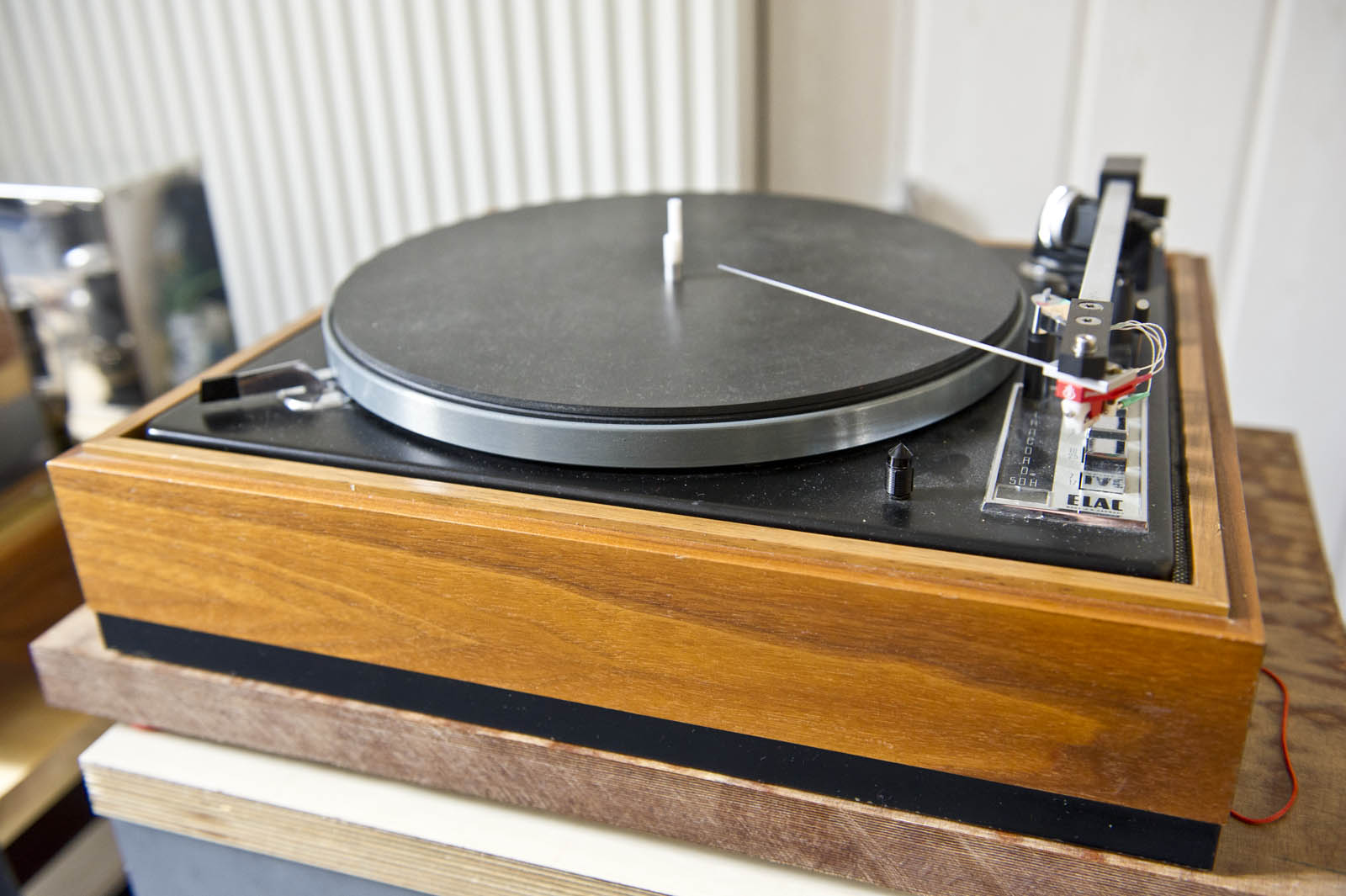
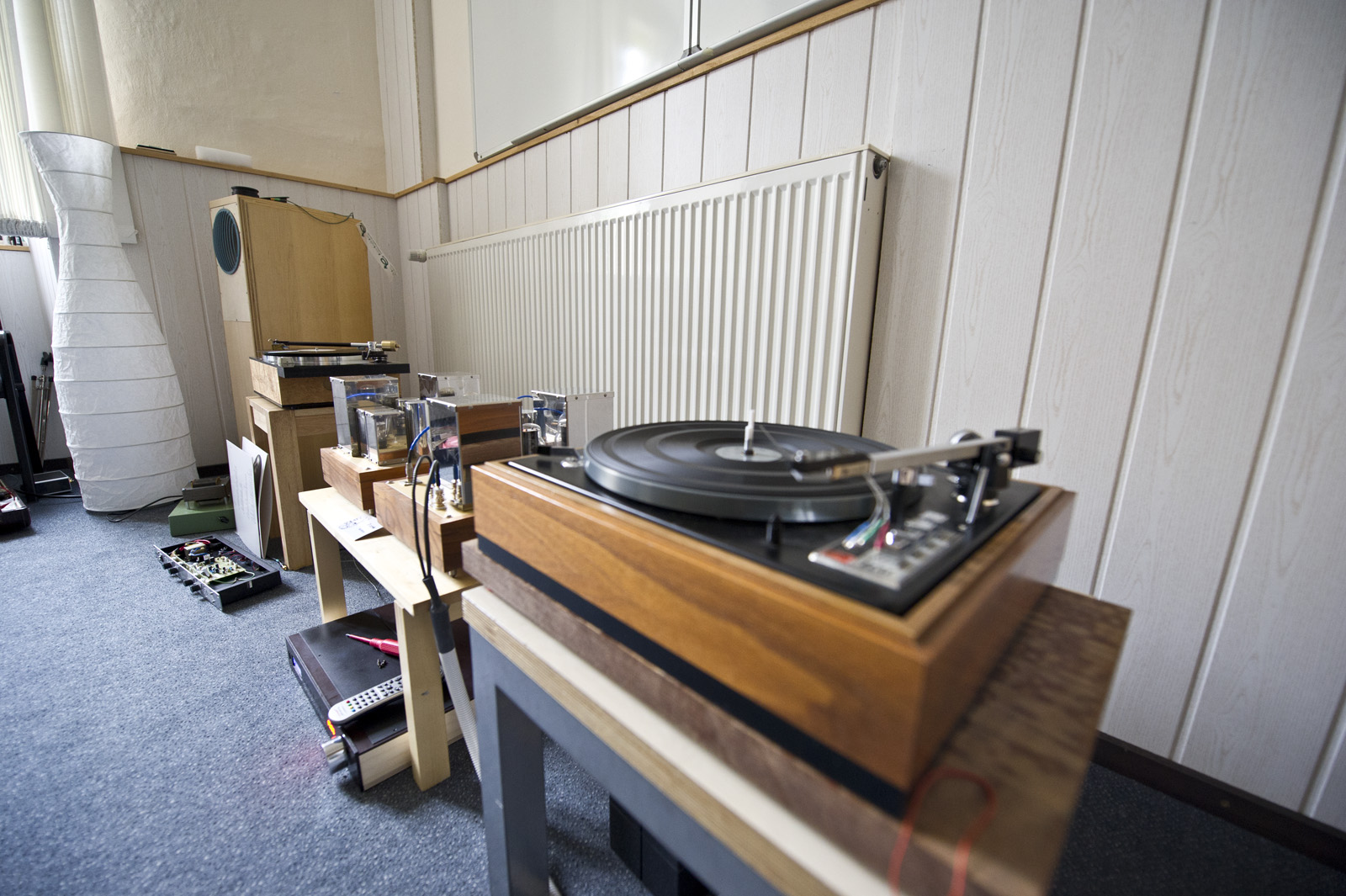
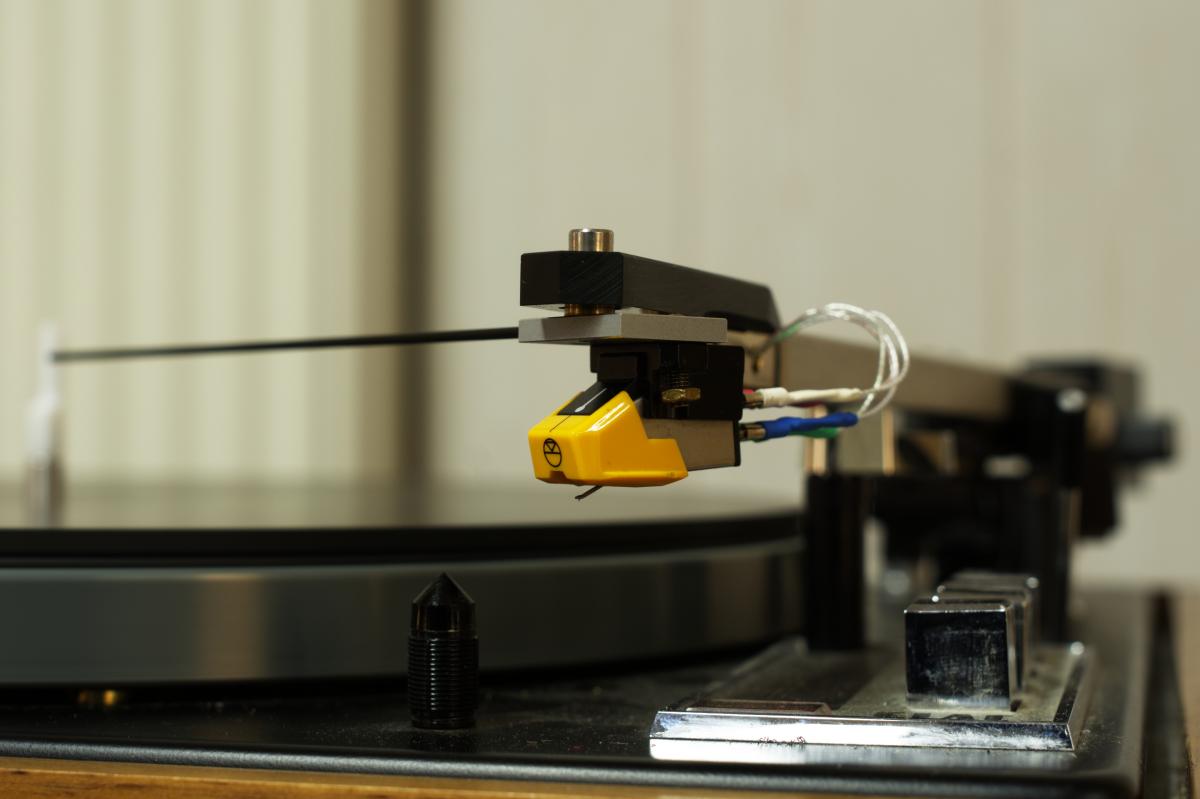
After 100 years, and with 1500 tonearm types sold, new inventions .....
This is just a simple "what if". In my Schuch-arm graph I noticed that the squares were tangent not only at the hipflask but also at the spindle (well, that was the condition I had set to have that geometry).
The Schroeder (great!) solution with the rotary shell seems to me rather different, like the geometry we're trying to obtain.
Skating: for now I'm trying to figure out how to rotate the whole thing, simplly to put a disk on the platter. I do not know yet if this mousetrap will work.
Interesting the string test (I missed it, thank you Ray), making a mockup I'll surely try: hoping that the rickshaw will go back along his rail. If not where?
Carlo
Thinking of good old vectors, may I ask a naive question? What is that moves a linear tonearm (true, not servo)?
This is just a simple "what if". In my Schuch-arm graph I noticed that the squares were tangent not only at the hipflask but also at the spindle (well, that was the condition I had set to have that geometry).
The Schroeder (great!) solution with the rotary shell seems to me rather different, like the geometry we're trying to obtain.
Skating: for now I'm trying to figure out how to rotate the whole thing, simplly to put a disk on the platter. I do not know yet if this mousetrap will work.
Interesting the string test (I missed it, thank you Ray), making a mockup I'll surely try: hoping that the rickshaw will go back along his rail. If not where?
Carlo
Thinking of good old vectors, may I ask a naive question? What is that moves a linear tonearm (true, not servo)?
Skating force (arm becomes angled to the tangent, so a force component towards spindle occurs, that again becomes zero when arm will be tangent).What is that moves a linear tonearm (true, not servo)?
- Home
- Source & Line
- Analogue Source
- Angling for 90° - tangential pivot tonearms
